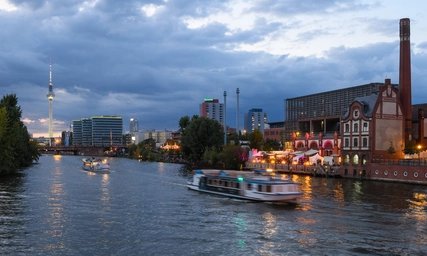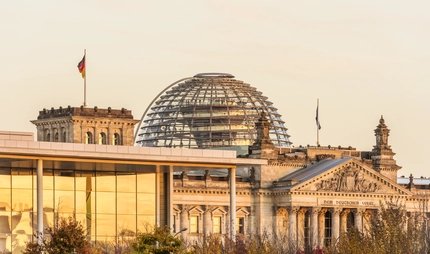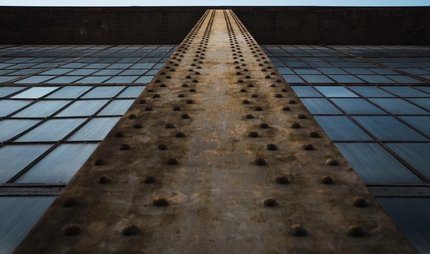
Berlin metropolis – The development of industrial culture
Berlin’s journey to a modern metropolis
The heavy traffic is moving, the neon signs are glowing and self-confident young women in short dresses are dancing in the nightclubs, while hip artists are creating important works: In the 1920s, Berlin was the world’s most prominent metropolis.
But without industrialisation, the metropolis of Berlin would not exist; it laid the foundation for the city as we know it today. In the early 20th century, Berlin was the largest industrial metropolis on the European continent.
Berlin – City of innovations

Prussia’s first railway, one of the first three-phase current power plants in Europe and the world’s first tram – many important achievements have come from Berlin. It is no coincidence that the city was nicknamed the “electropolis”, as the electrical industry has played an important role since the 1880s. Berlin shone in bright light.
Berlin was the testing ground for new technologies. The new electricity, water and transport systems served an exemplary function worldwide. Small backyard workshops like Siemens & Halske grew into global corporations and built new factories and business premises.
Electropolis Berlin - Electricity

And the electrification of machines, lighting, traffic and communication media changed the working and living environments of people – it was getting very “electrified”! Electrical cables and water and gas pipes ran through the underground of the city and supplied it with energy. In the city itself, substations, prominent buildings for regulating electricity, were being built.
Today, former substation Umspannwerk Ost is home to the entertaining Kriminal Theater while Umspannwerk Alexanderplatz is now an event venue. The Abspannwerk Buchhändlerhof gained international renown when the legendary techno club E-Werk opened its doors there in the 1990s.
By the way, you can learn everything about electricity at the Berlin Energy Museum in Steglitz, housed in a former power station.
Clinker bricks and steel skeletons – New architectural design language

Berlin possesses a large number of outstanding examples of industrial development like no other metropolis in Europe. Whether in Wedding or Tempelhof, in Pankow, Schöneberg, Schöneweide or Reinickendorf – the city made international economic and architectural history with its electrical industry, mechanical and railway engineering, communications and radio technology.
The imposing buildings of the up-and-coming industry changed the face of the city, initially in the style of imperial historicism, later in the style of New Objectivity. Peter Behrens built the AEG turbine factory, the modern factory made of glass and steel, a magnificent “cathedral of work. The landmark of numerous buildings is a simple design using clinker bricks, behind which steel skeletons are hidden. Berlin’s first high-rise buildings, the Wernerwerk and the Ullsteinhaus, were built and bear witness to the architects’ innovative ideas.
Living and working in the city
How are the people? How do the countless Berlin workers who made the city's path to becoming an industrial metropolis possible in the first place live? The housing shortage in the growing metropolis is enormous. In Berlin tenements around 1920, five or more people often shared one room. If some went to work, the others used the sleeping space. Almost none of the flats had a bathroom; instead there was a communal toilet in the yard or in the stairwell.
Representatives of the New Building Movement have long called for improving the housing conditions for poor sections of the population. But it was only after the collapse of the Empire in 1918 that urban planners and architects were given the opportunity to do so: In the new Weimar Republic, Berlin becomes a field of experimentation for the new, social goals of urban planning. Within a few years, new, innovative housing estates are built on the outskirts of the metropolis:
- Gartenstadt Falkenberg (Treptow), built in 1913-15 by Bruno Taut, open spaces by Ludwig Lesser.
- Schillerpark-Siedlung (Wedding), built 1924-30 by Bruno Taut and Franz Hoffmann, partial reconstruction 1951 by Max Taut, extension 1954-59 by Hans Hoffmann
- Großsiedlung Britz (Hufeisensiedlung) (Neukölln), 1925-31 built by Bruno Taut and Martin Wagner, open spaces by Leberecht Migge
- Carl Legien housing estate (Prenzlauer Berg), 1928-30 built by Bruno Taut and Franz Hillinger
- White City (Reinickendorf), 1929-31 built by Bruno Ahrends, Wilhelm Büning and Otto Rudolf Salvisberg, housing estate green by Ludwig Lesser
- Large housing estate Siemensstadt (Charlottenburg and Spandau), built 1929-31 by Otto Bartning, Fred Forbat, Walter Gropius, Hugo Häring, Paul Rudolf Henning, Hans Scharoun, open spaces by Leberecht Migge
Today they are UNESCO World Heritage Sites.

Every three years, a supra-regional festival in the cities of Berlin, Weimar and Dessau is dedicated to building culture and the ideas of modernism: the Triennale der Moderne.
Berlin – Symphony of a Metropolis

Dynamism and progress not only characterised the life of the metropolis through ever new factories and workshops, but also shaped science, art and people’s attitude to life. It was through them that modern life with electricity, railways and transport, with brightly lit streets at night and with new leisure activities was created. Artists such as Karl Eduard Biermann, Adolph von Menzel, Lesser Ury and Max Liebermann captured the factories and city life in their paintings.
The ever faster rhythm of the city can still be witnessed in the poignant silent film entitled Berlin – Symphony of a Metropolis.
New life in old walls

Backyards housing businesses, substations, factories and breweries – they still shape the face of the city today and provide spaces for innovative ideas and new creative uses. Artists and gallery owners from all over the world come to Berlin because they can find space for their art and realise their dreams here.
The Kulturbrauerei, a former brewery, is home to clubs, theatres and a cinema, while the Kindl brewery houses a centre for modern art. Other artists have set up their studios in Oberschöneweide, on the former AEG factory site.

Young start-ups with innovative ideas have moved into the Geyerwerke, where films were once copied. The Ullsteinhaus overlooks Tempelhof, where restaurants and shops – and a maritime flair – have created a new meeting point at the harbour basin.
Under the roof of the Malzfabrik in Tempelhof you will find artists and creative people at work, as well as studios, offices, conference rooms and even a concert hall.
Exhibition and performance spaces are available in the Kühlhaus in Kreuzberg, while fashion designers reveal the latest fashion trends on the catwalk during Berlin Fashion Week.
The Visitor Centre for Industrial Culture is located in the Schöneweide Industrial Museum – here you can find out everything you need to know about the topic and join interesting guided tours.



